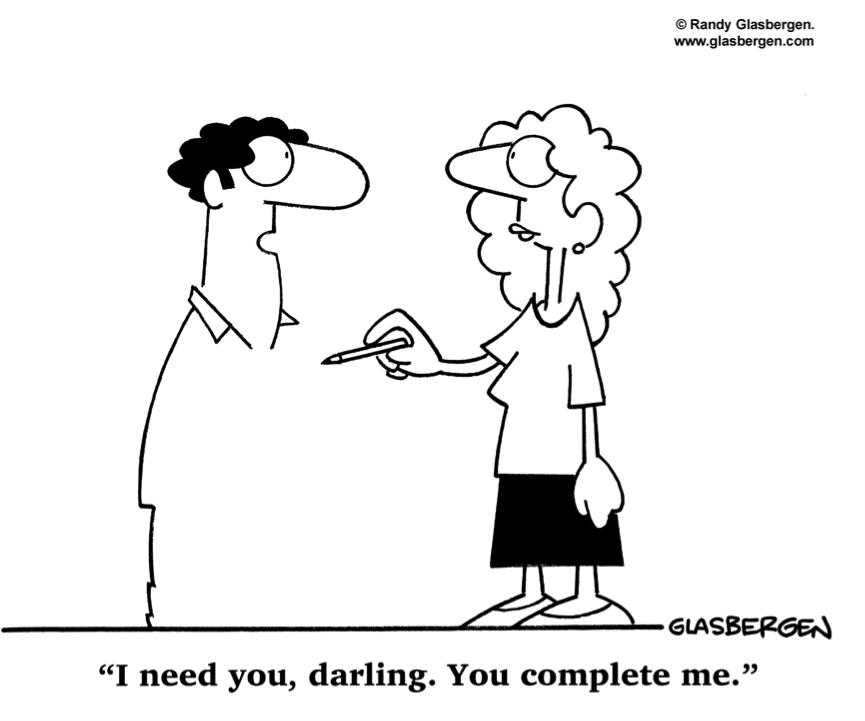There is a common experience all therapists encounter, no matter the sexual orientation or gender of the person or couple: A person describing their partner (or themselves) as “needy” or demanding. They complain about pressure for (or a lack of) affection, sex, attention, talk etc.
Yet our culture idealises the notion of needing your partner. “I need you” is generally offered up in a movie or book as the ultimate declaration of love, the height of romance. We are encouraged to give ourselves up or surrender to our partner.
So why is it that so many people complain about it??
Well, this cartoon offers a hint:
If this is your model for love, you could be trapped in a very vulnerable and dis-empowered position. Your identity is likely to be dependent upon the choices and behaviour of another person.
The answer to understanding how we could fall into this trap lies in understanding adult development, particularly the development that takes place in the context of relationships.
The state of passionate merger that is idealised in books & movies is only the first of many stages that a relationship can mature through over time. Colloquially it’s called the “honeymoon” phase (although it’s often over well before any commitment rituals are planned). Typically it lasts between 6 months to 2 years.
Therapists use words like “enmeshment”, “fusion”, “co-dependency” and even “temporary psychosis” to describe this stage. The leading clinicians in the area, Bader and Pearson (1988) formally label this stage “Symbiosis” and define it as “…a merging of lives, personalities, and intense bonding between the two lovers. The purpose of this stage is attachment. To allow for the merger, similarities are magnified and differences are overlooked” (p.9) . They note this stage as one of five stages of healthy couple relating.
In this stage, the rush to embrace our sameness and ignore our differences provides a space for bonding. Yet, that desire for sameness can create a false sense of security as, eventually, differences surface and need to be dealt with. If your sense of what’s OK in a relationship (or worse; your sense of personal “OKness”) is focused on constant agreement and sameness this can feel like a very threatening situation. And we all tend to get reactive when we are threatened. This is the mechanism whereby people get stuck in this stage – rather than embracing and learning to negotiate normal differences they are threatened by them, try to eliminate them by coercion, appeasement or avoidance. These are often the people who present with persistent problems in their relationship. Their state of fusion means they literally don’t know who they are without their partner.
These are the people who are saying to (or hearing from) their partner things like: “I can’t function if you won’t be with me/ have sex with me/tell me what’s going on with you/share my hobby/ etc”
We have a simple table that you can use with your clients to explore their beliefs around relationships and to help them understand the difference between “needing” and “wanting” in their relationship.
The difference between “need” & “want”: Why saying “I need you” is unromantic and NOT sexy
| When you say: | I NEED you | I WANT you |
| It’s about: | Dependance | Desire & Choice |
| The implicit message is: | “You have to” | “You are free to choose” |
| Your partner feels like a: | Thing | Desirable Person |
| It comes across as: | Controlling | An Invitation |
| The tone will feel: | Needy | Romantic (maybe even sexy) |
| You will seem: | Weak | Strong |
| Which is usually seen as: | Unappealing | Attractive |
We’ll be talking more about this table in later blog posts – telling you how to use it to explore attachment issues and more.

